cti4sw
Bronze Member
- Joined
- Jul 2, 2012
- Messages
- 1,555
- Reaction score
- 919
- Golden Thread
- 1
- Location
- Pennsylvania
- 🥇 Banner finds
- 1
- Detector(s) used
- Minelab Equinox 600, Garrett AT Pro, Pro Pointer
- Primary Interest:
- Relic Hunting
Found this today. Diameter appears to be exactly 2 inches (5.1 cm), will get a weight tomorrow. Should I get the weight in lbs/oz or kilograms?
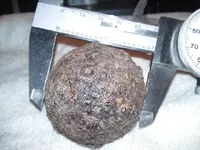
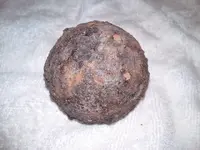
UPDATES:
Weight:
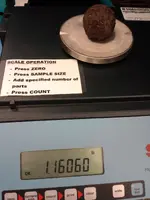
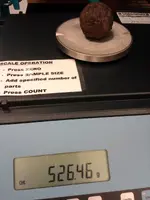
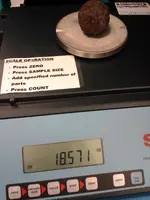
Diameter:
Diameter was measured with reference calipers in 4 places (measurement spots are limited due to roughness from corrosion): 1.9", 1.9", 1.91", 1.92".
I did use a soft buff grinding wheel on it, to wear down some of the corrosion. There are 3 spots on this ball that came out very smooth, indicating (to me at least) that at one time it was a very smooth-surfaced ball. I may take it to the buffer again periodically (and the belt sander too) to see if these "peaks" of corrosion can be eroded. But, for the most part, I think it looks pretty cool the way it is.
On another note, although my county was a hotbed of American Revolution activity (and, if this turns out to be a period cannonball, it will be my 3rd RW relic from here), I cannot rule out that since the house that fed the dump was dwelt by a man with a rather eccentric taste for collectibles, he may very well have picked this up elsewhere and it was discarded or lost much later.


UPDATES:
Weight:



Diameter:
Diameter was measured with reference calipers in 4 places (measurement spots are limited due to roughness from corrosion): 1.9", 1.9", 1.91", 1.92".
I did use a soft buff grinding wheel on it, to wear down some of the corrosion. There are 3 spots on this ball that came out very smooth, indicating (to me at least) that at one time it was a very smooth-surfaced ball. I may take it to the buffer again periodically (and the belt sander too) to see if these "peaks" of corrosion can be eroded. But, for the most part, I think it looks pretty cool the way it is.
On another note, although my county was a hotbed of American Revolution activity (and, if this turns out to be a period cannonball, it will be my 3rd RW relic from here), I cannot rule out that since the house that fed the dump was dwelt by a man with a rather eccentric taste for collectibles, he may very well have picked this up elsewhere and it was discarded or lost much later.
Last edited:



